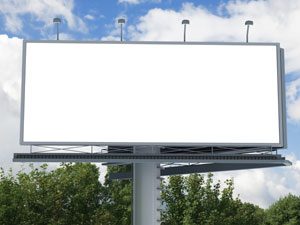
A question that people commonly ask us is what are billboards made out of? When it comes to the material most used to create traditional billboards, the answer is polyvinyl chloride (PVC) and polyethylene (PE). PVC has been the frontrunner in the billboard industry for decades. In recent years, PE has been introduced as a recyclable alternative in the billboard industry. No matter which option you choose, both are highly advantageous and serve as great materials to be used for the production of billboards. Now, let’s take a closer look at each of the two and what they have to offer.
Polyvinyl Chloride (PVC) Billboards
PVC is a commonly used plastic consisting of carbon, hydrogen, and chlorine. PVC has been a popular choice for billboard material as its very durable, easy to print on, and reasonably priced. Additionally, PVC billboards are designed to withstand harsh weather conditions so they are UV-protected and waterproof.
One disadvantage to PVC, especially for eco-friendly brands, is that its non-biodegradable. While this is a downfall, there are companies that specialize in reusing these billboards. Some companies resell these PVC billboards as pond liners and heavy-duty tarps. There’s even a unique company, Rareform, that repurposes these billboards into items like backpacks, duffle bags, and laptop sleeves. Despite these billboards being non-recyclable, these options at least find positive ways to alleviate the negative impact on the environment.
This article was originally published on BillboardsIn.com. You can continue reading the full article here.




